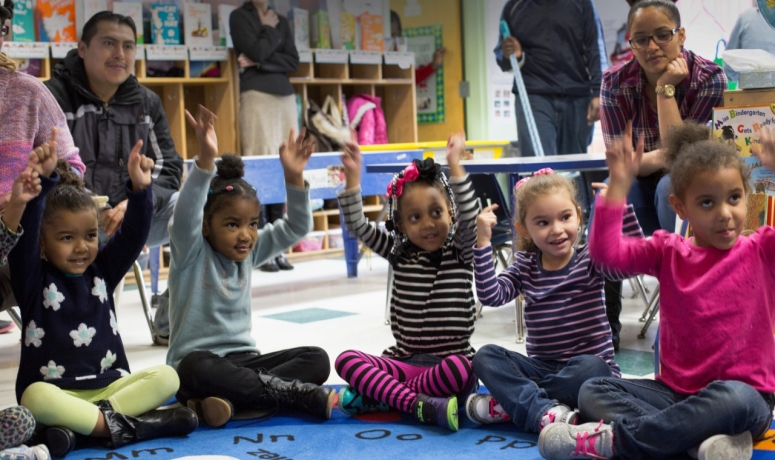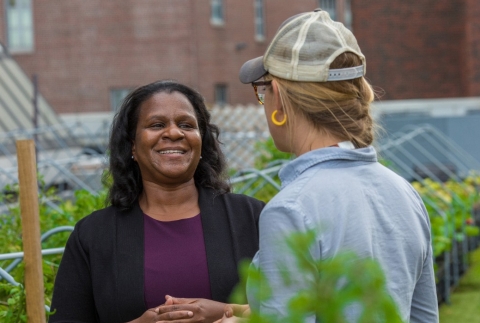Listening to Families and Communities to Address Childhood Obesity
Renee Boynton-Jarrett, MD, ScD, believes that children’s health and well-being are intricately and inextricably connected to their family and community.

When a mother walked into my health clinic five years ago with her 13-year-old daughter, she wanted to know why her daughter had gained a significant amount of weight in a matter of months. She was concerned an underlying medical condition might have caused the sudden spike her daughter’s weight. I was concerned as well. Childhood obesity is an epidemic that affects far too many children and it is linked to other serious, chronic health conditions, including high blood pressure, type 2 diabetes, heart disease, and asthma.
I knew I would run tests and order blood work, but I also wanted to know what factors in her social world could have sparked the weight change. We sat down together to look at her daughter’s growth chart, see when the growth trajectory started to accelerate, and what could have been happening then. “Did anything change in your family? Do you recall anything that happened around that time?”
The mom suddenly realized that the changes started shortly after the girl’s father was incarcerated. That’s information I could not have gotten from a blood test. Nor if I had rattled off recommendations without first sitting down to listen.
Understanding Impacts of Adverse Early Life Experiences
I began my career as a primary care pediatrician. I also trained as an epidemiologist with a focus on social factors in community environments that can contribute to health and well-being. As a result, my perspective on what impacts health and strategies to improve it that go beyond clinical treatment and prescriptions; we must also consider the environments where children learn and play, and structural conditions that impact opportunities to achieve health. Through my work in public health and primary care, I know that children who are exposed daily to struggles like food insecurity, unstable housing, and violence in the home or community face long-term impacts on their health.
The experience of the young girl in Boston was not unlike countless of others’ experiences across the United States. Nationwide, 4.8 million young people ages 10 to 17 have obesity, according to data released by National Survey of Children’s Health and highlighted in the State of Childhood Obesity report.

The national rate of obesity for young people ages 10 to 17 is 15.3 percent, a rate that has remained fairly steady for the past few years. Rates among black and Hispanic youth (22.2 percent and 19.0 percent, respectively) are significantly higher than for white and Asian youth (11.8 percent and 7.3 percent, respectively). These racial and ethnic disparities have persisted over time and are demonstrated by other major obesity surveys.
Helping children maintain a healthy weight from an early age is essential to preventing a wide range of health problems, particularly for communities of color. But obesity is complex. It can’t be solved reactively or prevented through health care interventions alone. My philosophy around keeping children and families healthy has changed from playing a traditional educator/practitioner role to more of a listener/facilitator role where I work collaboratively with patients and families. They have their own insights, are familiar with neighborhood conditions and resources, and know what goals and solutions are feasible for them.
Adverse childhood experiences and socially adverse neighborhood conditions are not one dimensional. Social adversities can impact biology, behavior, development, and health. For example, addressing food insecurity offers a significant opportunity to prevent obesity. The population of children who experience food insecurity is also the population of children most likely to experience obesity or a less than optimal weight or growth trajectory, but approaches to end hunger and approaches to prevent obesity operate independently of each other.
Boston’s Community-Based Approach to Address Adverse Neighborhood Conditions
In Boston, we work collaboratively to break down these silos and address issues like food insecurity more holistically and at the community level. For example, at Boston Medical Center in 2010, I founded the Vital Village Community Engagement Network, a grassroots network of residents and organizations committed to maximizing child, family, and community well-being, to build the capacity of communities to work collectively with caregivers and residents to promote well-being. The Vital Village Data Workgroup, a group of resident leaders, recently developed the concept and designed the Abundance app, which enables people in the Boston community to map the closest food resources. It’s a way of identifying food deserts as a first step in addressing food insecurity in that particular area.
I believe that we have to not only listen to our communities, but also engage them in shared decision-making, governance, and leadership in promoting well-being and health. We also have to think about integrating policies and collaborating across sectors—including education, health, crime, housing, and the built environment—to truly create an environment that supports healthy growth and development for kids.
Learn more about my perspective and how the city of Boston is helping to ensure that more children have consistent access to healthy foods from the earliest days of life to help them grow up at a healthy weight at www.StateOfChildhoodObesity.org.
Note: This blog is cross-posted from the Robert Wood Johnson Foundation Culture of Health Blog.

